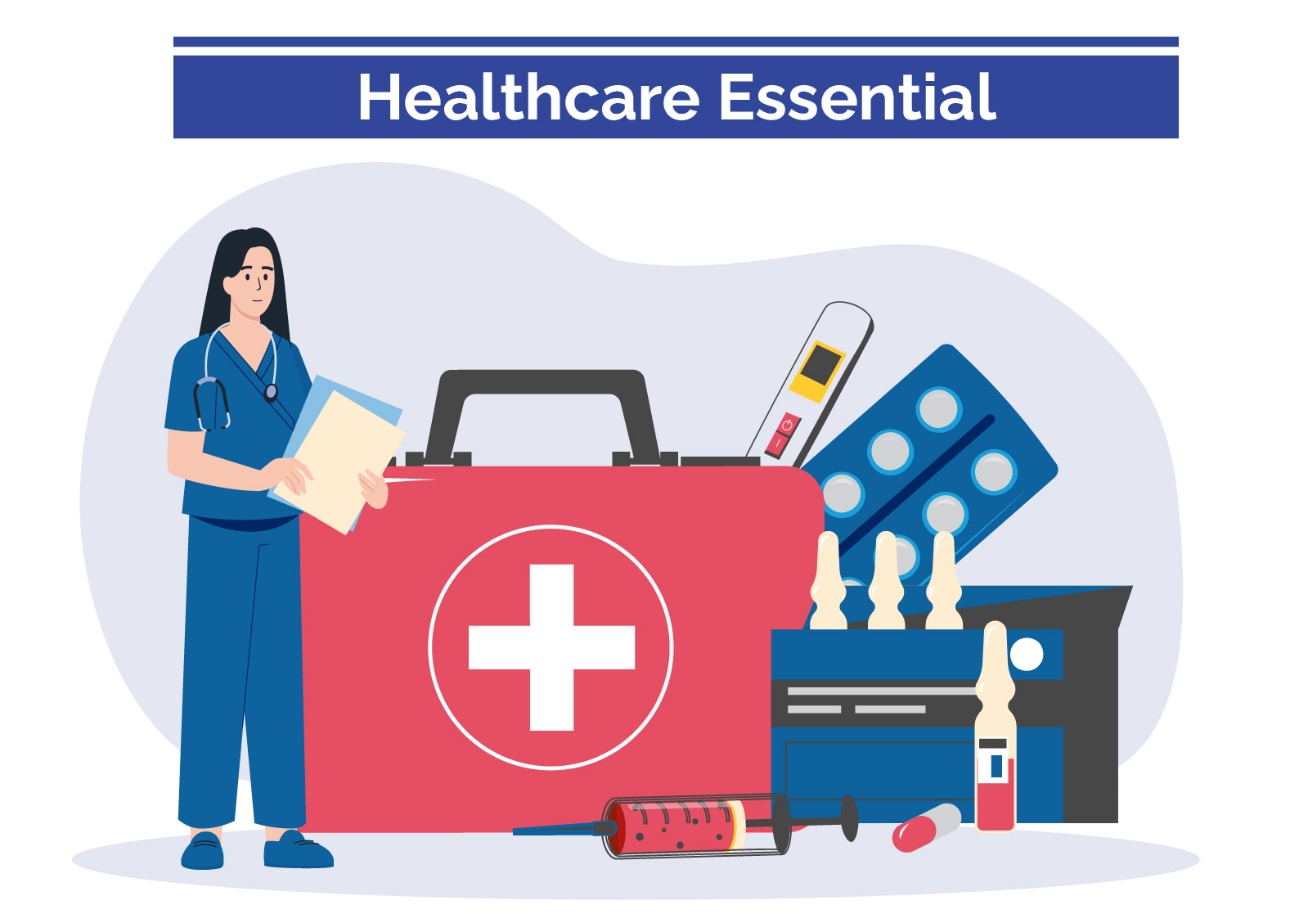Emergencies are unpredictable and can occur at any moment, making it crucial to be prepared with a well-stocked first aid kit. Whether you’re at home, on the road, or working in a high-risk environment, knowing what to include in your first aid kit and how to use these items effectively can make all the difference.
This blog will guide you through the essential components of a first aid kit, their purposes, and uses while also emphasizing the importance of comprehensive first aid training courses and related safety training services.
Understanding the Importance of a First Aid Kit:
A first aid kit is more than just a collection of medical supplies; it’s an essential tool for managing injuries and emergencies before professional medical help arrives. Having a well-equipped kit allows you to address minor injuries immediately and provide crucial support during more serious situations.
In addition to having the right supplies, knowing how to use them effectively is equally important. This is where first aid training comes into play. Various levels of first aid training courses, including basic, intermediate, and advanced options, offer valuable skills for handling emergencies.

First aid essentials laid out, including bandages, antiseptic ointments, and medical tools for effective injury treatment.
Essential Components of a First Aid Kit:
Your first aid kit should be tailored to your specific needs, whether for home use, travel, or workplace settings. Here’s a comprehensive overview of the essential items to include, along with their purposes and usage.
Adhesive Bandages and Dressings:
Adhesive bandages are fundamental components of any first aid kit. They come in various sizes and types, designed to cover small cuts, blisters, or abrasions. Larger sterile dressings are necessary for covering more significant wounds or burns. Adhesive bandages protect the wound from infection and further injury.
Knowing how to apply these bandages correctly is a key component of basic first aid training, ensuring that wounds are properly covered and protected.
Antiseptics and Antibiotic Ointments:
Antiseptics, such as alcohol wipes or iodine solutions, are crucial for cleaning wounds to prevent infection. They help remove dirt and bacteria from the wound site, reducing the risk of complications. Antibiotic ointments provide an additional layer of protection by killing bacteria and promoting healing.
Proper use of these items helps to manage wounds effectively and prevent infection, a fundamental aspect of intermediate first aid courses.
Sterile Gauze Pads and Adhesive Tape:
Gauze pads are used to control bleeding by applying direct pressure to the wound. They also serve as a barrier between the wound and the bandage or dressing. Sterile gauze pads are essential for preventing infection and should be used with adhesive tape to secure them in place.
Learning how to use these materials effectively is vital for effective first aid, covered in both basic and advanced first aid courses.
Scissors and Tweezers:
Scissors are necessary for cutting tape, gauze, or bandages, while tweezers are useful for removing splinters or debris from wounds. Ensuring these tools are included in your first aid kit helps you manage a variety of injuries more efficiently.
Training in their proper use is part of comprehensive first aid training courses, providing you with the skills to handle different types of injuries.
Medical Adhesive and Gloves:
Medical adhesive helps to secure bandages or dressings, ensuring that they stay in place and provide effective protection. Disposable gloves are essential for maintaining hygiene while administering first aid. They protect both the injured person and the responder from potential infections.
The importance of hygiene and proper glove use is emphasized in advanced first aid courses, highlighting the need for safe and effective care.
Thermometer and Tweezers:
A thermometer is useful for monitoring body temperature, which can be crucial in detecting fever or hypothermia. A thermometer helps assess whether a person has a high fever that may require medical attention. Tweezers are handy for removing splinters or foreign objects from wounds.
Proper use of these tools is a part of both basic and advanced first aid training, ensuring that you can manage a range of medical situations effectively.
CPR Face Shield and Emergency Blanket:
A CPR face shield is used during cardiopulmonary resuscitation (CPR) to provide a barrier between the responder and the patient, minimizing the risk of disease transmission. An emergency blanket helps retain body heat in cases of shock or hypothermia.
Mastery of CPR techniques and the use of emergency blankets are integral components of first aid training, ensuring that you are prepared to provide critical care during emergencies.

A well-organized first aid kit ready for any emergency
The Role of Specialized Training in Emergency Preparedness:
Having a first aid kit is essential, but knowing how to use it effectively is equally important. Specialized training can enhance your skills and improve your readiness for various emergency scenarios. First aid training courses offer a range of levels to suit different needs:
Basic First Aid Training: This foundational course covers essential skills for addressing common injuries and health issues. It is suitable for general public use and provides a solid understanding of basic first aid principles. Participants learn how to handle minor cuts, burns, sprains, and other common injuries.
Intermediate First Aid Courses: Intermediate courses offer more in-depth knowledge and skills, addressing a broader range of emergencies and complex scenarios. These courses are beneficial for those who require a higher level of preparedness, such as those in roles with increased risk or responsibility.
Advanced First Aid Courses: Advanced training is designed for individuals who need to handle severe emergencies with specialized techniques and knowledge. This training is ideal for those in higher-risk professions or roles requiring advanced first-aid skills. Topics covered may include advanced wound care, emergency medical response, and critical care techniques.
In addition to first aid training, specialized courses like fall protection training and confined space training are essential for specific environments:
Maintaining Safety in High-Risk Environments:
For workplaces with specific hazards, such as those requiring fall protection or confined space training, having a well-prepared first aid kit and proper training is essential. These measures ensure that you’re ready to manage injuries and health issues specific to your environment.
Regularly reviewing and updating your first aid kit is important to ensure it remains equipped to handle evolving needs and risks. Conducting regular drills and training sessions helps reinforce safety procedures and ensures that everyone is familiar with emergency protocols.
Fall Protection Equipment: In industries where falls are a common risk, having fall protection gear in your first aid kit is crucial. This equipment can help manage injuries resulting from falls and ensure that you are prepared for emergencies in high-risk areas. Including items like harnesses, lanyards, and fall arrest systems can be essential in such settings.
Confined Space Gear: For workplaces that require confined space training, including gear designed for emergencies in confined spaces is essential. This gear can help manage injuries and health issues specific to these challenging environments. Items might include specialized rescue equipment and tools for accessing confined areas safely.
Combining this specialized training with a well-stocked first aid kit ensures that you’re thoroughly prepared for different types of emergencies and workplace hazards.
Effective Use of Your First Aid Kit:
Having the right items in your first aid kit is crucial, but knowing how to use them effectively is equally important. During an emergency, stay calm and assess the situation before administering first aid. Use the appropriate items from your kit based on the type of injury or condition.
For example, clean a wound with antiseptic before applying a sterile dressing. If the injury is severe or you are unsure about the treatment, seek professional medical help promptly.
Training plays a significant role in ensuring that you can use your first aid kit effectively. First-aid training courses provide valuable knowledge and practical skills for managing various medical situations. Whether you have basic, intermediate, or advanced training, the skills you acquire will enhance your ability to respond confidently to emergencies.
An emergency first aid kit is an essential component of any safety plan, whether for home, travel, or the workplace. By including essential items and understanding their uses, you can manage injuries effectively and provide timely care. Complementing your kit with thorough first aid training, including basic, intermediate, and advanced courses, as well as specialized training in fall protection and confined spaces, ensures that you are well-prepared for any emergency.
For expert guidance on first aid training and to ensure you have the skills needed for effective emergency response, consider enrolling in courses offered by Metro Safety Training. We provide comprehensive first-aid training courses in Vancouver and Surrey, equipping you with the knowledge and confidence to handle various situations.
Contact us today in Vancouver and Surrey to learn more and ensure that you’re ready for any situation.








